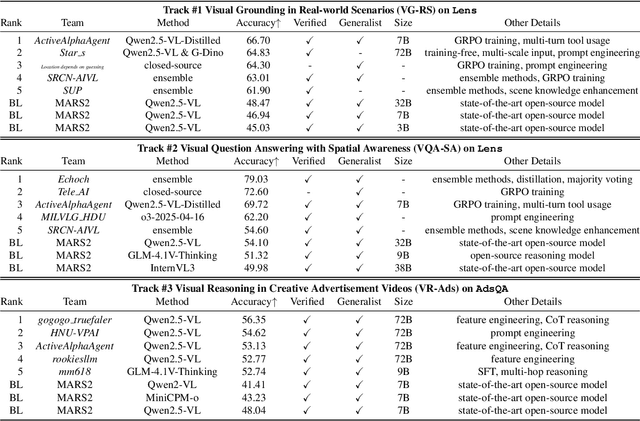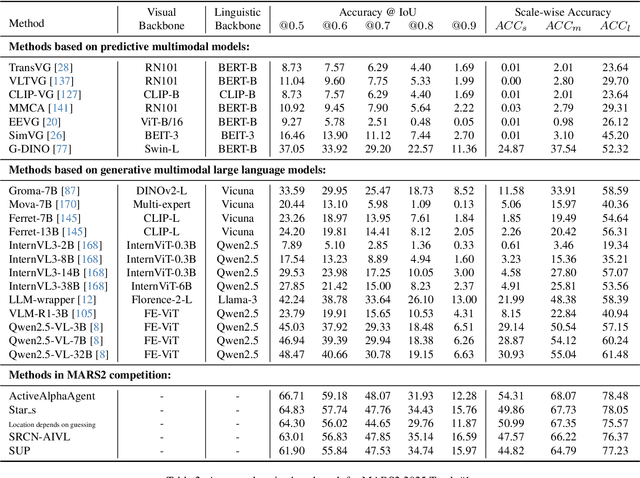Yi Wen
Jack
MARS2 2025 Challenge on Multimodal Reasoning: Datasets, Methods, Results, Discussion, and Outlook
Sep 17, 2025



Abstract:This paper reviews the MARS2 2025 Challenge on Multimodal Reasoning. We aim to bring together different approaches in multimodal machine learning and LLMs via a large benchmark. We hope it better allows researchers to follow the state-of-the-art in this very dynamic area. Meanwhile, a growing number of testbeds have boosted the evolution of general-purpose large language models. Thus, this year's MARS2 focuses on real-world and specialized scenarios to broaden the multimodal reasoning applications of MLLMs. Our organizing team released two tailored datasets Lens and AdsQA as test sets, which support general reasoning in 12 daily scenarios and domain-specific reasoning in advertisement videos, respectively. We evaluated 40+ baselines that include both generalist MLLMs and task-specific models, and opened up three competition tracks, i.e., Visual Grounding in Real-world Scenarios (VG-RS), Visual Question Answering with Spatial Awareness (VQA-SA), and Visual Reasoning in Creative Advertisement Videos (VR-Ads). Finally, 76 teams from the renowned academic and industrial institutions have registered and 40+ valid submissions (out of 1200+) have been included in our ranking lists. Our datasets, code sets (40+ baselines and 15+ participants' methods), and rankings are publicly available on the MARS2 workshop website and our GitHub organization page https://github.com/mars2workshop/, where our updates and announcements of upcoming events will be continuously provided.
RDDM: Practicing RAW Domain Diffusion Model for Real-world Image Restoration
Aug 26, 2025Abstract:We present the RAW domain diffusion model (RDDM), an end-to-end diffusion model that restores photo-realistic images directly from the sensor RAW data. While recent sRGB-domain diffusion methods achieve impressive results, they are caught in a dilemma between high fidelity and realistic generation. As these models process lossy sRGB inputs and neglect the accessibility of the sensor RAW images in many scenarios, e.g., in image and video capturing in edge devices, resulting in sub-optimal performance. RDDM bypasses this limitation by directly restoring images in the RAW domain, replacing the conventional two-stage image signal processing (ISP) + IR pipeline. However, a simple adaptation of pre-trained diffusion models to the RAW domain confronts the out-of-distribution (OOD) issues. To this end, we propose: (1) a RAW-domain VAE (RVAE) learning optimal latent representations, (2) a differentiable Post Tone Processing (PTP) module enabling joint RAW and sRGB space optimization. To compensate for the deficiency in the dataset, we develop a scalable degradation pipeline synthesizing RAW LQ-HQ pairs from existing sRGB datasets for large-scale training. Furthermore, we devise a configurable multi-bayer (CMB) LoRA module handling diverse RAW patterns such as RGGB, BGGR, etc. Extensive experiments demonstrate RDDM's superiority over state-of-the-art sRGB diffusion methods, yielding higher fidelity results with fewer artifacts.
Measure Domain's Gap: A Similar Domain Selection Principle for Multi-Domain Recommendation
May 26, 2025Abstract:Multi-Domain Recommendation (MDR) achieves the desirable recommendation performance by effectively utilizing the transfer information across different domains. Despite the great success, most existing MDR methods adopt a single structure to transfer complex domain-shared knowledge. However, the beneficial transferring information should vary across different domains. When there is knowledge conflict between domains or a domain is of poor quality, unselectively leveraging information from all domains will lead to a serious Negative Transfer Problem (NTP). Therefore, how to effectively model the complex transfer relationships between domains to avoid NTP is still a direction worth exploring. To address these issues, we propose a simple and dynamic Similar Domain Selection Principle (SDSP) for multi-domain recommendation in this paper. SDSP presents the initial exploration of selecting suitable domain knowledge for each domain to alleviate NTP. Specifically, we propose a novel prototype-based domain distance measure to effectively model the complexity relationship between domains. Thereafter, the proposed SDSP can dynamically find similar domains for each domain based on the supervised signals of the domain metrics and the unsupervised distance measure from the learned domain prototype. We emphasize that SDSP is a lightweight method that can be incorporated with existing MDR methods for better performance while not introducing excessive time overheads. To the best of our knowledge, it is the first solution that can explicitly measure domain-level gaps and dynamically select appropriate domains in the MDR field. Extensive experiments on three datasets demonstrate the effectiveness of our proposed method.
Efficient Reasoning via Chain of Unconscious Thought
May 26, 2025Abstract:Large Reasoning Models (LRMs) achieve promising performance but compromise token efficiency due to verbose reasoning processes. Unconscious Thought Theory (UTT) posits that complex problems can be solved more efficiently through internalized cognitive processes. Inspired by UTT, we propose a new reasoning paradigm, termed Chain of Unconscious Thought (CoUT), to improve the token efficiency of LRMs by guiding them to mimic human unconscious thought and internalize reasoning processes. Concretely, we first prompt the model to internalize the reasoning by thinking in the hidden layer. Then, we design a bag of token-efficient strategies to further help models reduce unnecessary tokens yet preserve the performance. Our work reveals that models may possess beneficial unconscious thought, enabling improved efficiency without sacrificing performance. Extensive experiments demonstrate the effectiveness of CoUT. Remarkably, it surpasses CoT by reducing token usage by 47.62% while maintaining comparable accuracy, as shown in Figure 1. The code of CoUT is available at this link: https://github.com/Rohan-GRH/CoUT
Towards Multi-Granularity Memory Association and Selection for Long-Term Conversational Agents
May 26, 2025Abstract:Large Language Models (LLMs) have recently been widely adopted in conversational agents. However, the increasingly long interactions between users and agents accumulate extensive dialogue records, making it difficult for LLMs with limited context windows to maintain a coherent long-term dialogue memory and deliver personalized responses. While retrieval-augmented memory systems have emerged to address this issue, existing methods often depend on single-granularity memory segmentation and retrieval. This approach falls short in capturing deep memory connections, leading to partial retrieval of useful information or substantial noise, resulting in suboptimal performance. To tackle these limits, we propose MemGAS, a framework that enhances memory consolidation by constructing multi-granularity association, adaptive selection, and retrieval. MemGAS is based on multi-granularity memory units and employs Gaussian Mixture Models to cluster and associate new memories with historical ones. An entropy-based router adaptively selects optimal granularity by evaluating query relevance distributions and balancing information completeness and noise. Retrieved memories are further refined via LLM-based filtering. Experiments on four long-term memory benchmarks demonstrate that MemGAS outperforms state-of-the-art methods on both question answer and retrieval tasks, achieving superior performance across different query types and top-K settings.
A Survey of Personalization: From RAG to Agent
Apr 14, 2025Abstract:Personalization has become an essential capability in modern AI systems, enabling customized interactions that align with individual user preferences, contexts, and goals. Recent research has increasingly concentrated on Retrieval-Augmented Generation (RAG) frameworks and their evolution into more advanced agent-based architectures within personalized settings to enhance user satisfaction. Building on this foundation, this survey systematically examines personalization across the three core stages of RAG: pre-retrieval, retrieval, and generation. Beyond RAG, we further extend its capabilities into the realm of Personalized LLM-based Agents, which enhance traditional RAG systems with agentic functionalities, including user understanding, personalized planning and execution, and dynamic generation. For both personalization in RAG and agent-based personalization, we provide formal definitions, conduct a comprehensive review of recent literature, and summarize key datasets and evaluation metrics. Additionally, we discuss fundamental challenges, limitations, and promising research directions in this evolving field. Relevant papers and resources are continuously updated at https://github.com/Applied-Machine-Learning-Lab/Awesome-Personalized-RAG-Agent.
Hi-Mamba: Hierarchical Mamba for Efficient Image Super-Resolution
Oct 14, 2024



Abstract:State Space Models (SSM), such as Mamba, have shown strong representation ability in modeling long-range dependency with linear complexity, achieving successful applications from high-level to low-level vision tasks. However, SSM's sequential nature necessitates multiple scans in different directions to compensate for the loss of spatial dependency when unfolding the image into a 1D sequence. This multi-direction scanning strategy significantly increases the computation overhead and is unbearable for high-resolution image processing. To address this problem, we propose a novel Hierarchical Mamba network, namely, Hi-Mamba, for image super-resolution (SR). Hi-Mamba consists of two key designs: (1) The Hierarchical Mamba Block (HMB) assembled by a Local SSM (L-SSM) and a Region SSM (R-SSM) both with the single-direction scanning, aggregates multi-scale representations to enhance the context modeling ability. (2) The Direction Alternation Hierarchical Mamba Group (DA-HMG) allocates the isomeric single-direction scanning into cascading HMBs to enrich the spatial relationship modeling. Extensive experiments demonstrate the superiority of Hi-Mamba across five benchmark datasets for efficient SR. For example, Hi-Mamba achieves a significant PSNR improvement of 0.29 dB on Manga109 for $\times3$ SR, compared to the strong lightweight MambaIR.
The Llama 3 Herd of Models
Jul 31, 2024Abstract:Modern artificial intelligence (AI) systems are powered by foundation models. This paper presents a new set of foundation models, called Llama 3. It is a herd of language models that natively support multilinguality, coding, reasoning, and tool usage. Our largest model is a dense Transformer with 405B parameters and a context window of up to 128K tokens. This paper presents an extensive empirical evaluation of Llama 3. We find that Llama 3 delivers comparable quality to leading language models such as GPT-4 on a plethora of tasks. We publicly release Llama 3, including pre-trained and post-trained versions of the 405B parameter language model and our Llama Guard 3 model for input and output safety. The paper also presents the results of experiments in which we integrate image, video, and speech capabilities into Llama 3 via a compositional approach. We observe this approach performs competitively with the state-of-the-art on image, video, and speech recognition tasks. The resulting models are not yet being broadly released as they are still under development.
Augmented Physics: A Machine Learning-Powered Tool for Creating Interactive Physics Simulations from Static Diagrams
May 28, 2024



Abstract:We introduce Augmented Physics, a machine learning-powered tool designed for creating interactive physics simulations from static textbook diagrams. Leveraging computer vision techniques, such as Segment Anything and OpenCV, our web-based system enables users to semi-automatically extract diagrams from physics textbooks and then generate interactive simulations based on the extracted content. These interactive diagrams are seamlessly integrated into scanned textbook pages, facilitating interactive and personalized learning experiences across various physics concepts, including gravity, optics, circuits, and kinematics. Drawing on an elicitation study with seven physics instructors, we explore four key augmentation techniques: 1) augmented experiments, 2) animated diagrams, 3) bi-directional manipulatives, and 4) parameter visualization. We evaluate our system through technical evaluation, a usability study (N=12), and expert interviews (N=12). The study findings suggest that our system can facilitate more engaging and personalized learning experiences in physics education.
Collaboration of Teachers for Semi-supervised Object Detection
May 22, 2024



Abstract:Recent semi-supervised object detection (SSOD) has achieved remarkable progress by leveraging unlabeled data for training. Mainstream SSOD methods rely on Consistency Regularization methods and Exponential Moving Average (EMA), which form a cyclic data flow. However, the EMA updating training approach leads to weight coupling between the teacher and student models. This coupling in a cyclic data flow results in a decrease in the utilization of unlabeled data information and the confirmation bias on low-quality or erroneous pseudo-labels. To address these issues, we propose the Collaboration of Teachers Framework (CTF), which consists of multiple pairs of teacher and student models for training. In the learning process of CTF, the Data Performance Consistency Optimization module (DPCO) informs the best pair of teacher models possessing the optimal pseudo-labels during the past training process, and these most reliable pseudo-labels generated by the best performing teacher would guide the other student models. As a consequence, this framework greatly improves the utilization of unlabeled data and prevents the positive feedback cycle of unreliable pseudo-labels. The CTF achieves outstanding results on numerous SSOD datasets, including a 0.71% mAP improvement on the 10% annotated COCO dataset and a 0.89% mAP improvement on the VOC dataset compared to LabelMatch and converges significantly faster. Moreover, the CTF is plug-and-play and can be integrated with other mainstream SSOD methods.
 Add to Chrome
Add to Chrome Add to Firefox
Add to Firefox Add to Edge
Add to Edge